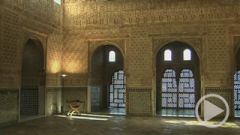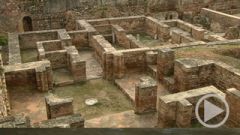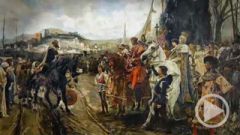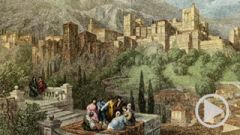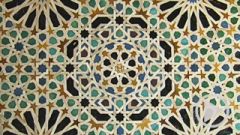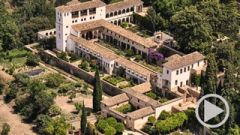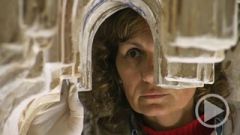The Nasrid Palaces
The Nasrid Palaces
The Nasrid palaces consist of three autonomous but cohesive areas: the Mexuar Palace, the Comares Palace and the Palace of the Lions. Although they form part of an ensemble, each individual palace can be assigned to a particular sultan.
One of the oldest buildings is the Mexuar Palace: audience chamber and court of justice. The central building was erected by Ismail I., the fifth sultan of Granada. Here he used to sit, listen to his ministers and administer justice. Again, verses by Ibn al-Jatib conjure up an image of the original chamber. "Congratulations on your successful construction, sanctuary for days of counsel and dispensation; how beautiful its cupola that, high as the sky, rises up above the gaze of the observer!"
The cupola, which was made of wood and coloured glass, no longer exists. But the ceiling of the Mirador de Lindaraja in the Palace of the Lions provides an impression of its former beauty.
There are conflicting statements about Sultan Ismail in historical chronicles. In the year 1319, the Spanish princes Pedro and Juan attempted to capture Granada. They and many other Christian knights paid with their lives in the battle of the Sierra Elvira. Some sources report that Ismail arranged for Prince Juan’s body to be sent back to Cordoba escorted by a guard of honour. Others, primarily Islamic sources, claim that Juan’s stuffed corpse was hung from the gate of the Alhambra. A propaganda war in the Middle Ages.
Behind a narrow passageway is the quadrangle of the “Cuarto Dorado” or “Golden Room”. The courtyard was a security zone and could only be accessed one by one through the small door. It served as an interface between semi-public and private spheres.
The façade of the Comares Palace provided the backdrop for magnificent royal ceremonies. The sultan himself sat in the centre, in a prominent position - a demonstration of power. His throne: a luxurious but also portable seat.
Directly alongside the throne there’s a corridor which leads in a zigzag direction to the Comares Palace proper. Emerging from the corridor, the view widens: the myrtle courtyard with its fountain is the fulcrum of courtly life, surrounded by the chambers of the palace.
The Comares Palace was built by Ismail’s son, Yusuf I. First the Sala de las Barcas, or Hall of the Boats. It is reminiscent of an awning, opening out in front of the sultan’s large tent.

The throne room itself is the centre of power. A place where heavenly and earthly power meet. One of the shining examples of Nasrid architecture. One of the nine alcoves stands out from the regular décor. This is where the sultan resided. Typical of the Nasrids: the function of the room changes. Even a representative room such as this was also used privately. While he was in office, Yusuf I. built the famous Madrasa academy in Granada: a centre for knowledge and faith. This interior is one of the most outstanding of its kind in the entire Alhambra. The ceiling is a masterpiece of Islamic artistry.
The wooden construction is a representation of heaven: the soul of the devout must overcome seven heavens. The eighth is paradise, the throne of god – a small cupola with a typical stalactite vault. The vertices of the ceiling represent the roots of the trees of paradise. Yusuf conducted his government business beneath this sky. This fact is also recorded in the inscription in the alcoves, a poem.
José Miguel Puerta Vílchez, Arabist and Professor of Art History, University of Granada:
"It’s interesting to take a closer look at the last part of the poem. It makes specific reference to the fact that the throne of Yusuf I. was positioned on this spot. And my master Yusuf spoke [...] and he transformed me into the throne of the empire [...] which protects me with the heavenly light, the chair and the throne – three concepts from the Koran, that allude to the enthronement of God above the seven heavens."
The Hammam is directly next door. An indispensable element of the palaces: there are more than a dozen of them in the Alhambra. Islam has always set great store by bodily hygiene and ritual cleansing. But for guests, a visit to the bathhouse was also a pleasurable, convivial experience.
The Sala de las Camas, or Hall of the Beds, was a place to get changed and relax. Most striking here are the hall’s decorative elements: the pillars, the wood panelling – everything is brightly coloured.
Only the pillars, fountains and floor coverings are original. The vibrant colours of the plasterwork were applied during the course of the 19th century. They nevertheless provide a good impression of how the interior spaces of the Alhambra may have looked: the wall decorations were multi-coloured, primarily black, red and blue. Passages from the Koran were set with gold leaf.
Massage room, steam bath, various pools with cool and warm water: the hammam was divided up into several different sections. By adjusting the skylights, one could regulate the steam of the bath. To heat the rooms, pipes were laid from the central boiler beneath the marble floor. But bathers had to proceed with caution: when crossing the floors, it was advisable to wear shoes with thick soles.
The Nasrid empire attained its economic and cultural heyday in the mid-14th century. Towering figures of Arab spiritual life came to visit Granada. But life at the court was anything but peaceful. There were frequent plots, incidences of betrayal and murder, even among the closest family members. Few rulers of the Alhambra died a natural death – and neither did Yusuf. On 19 October 1354, the sultan was at prayer when he was stabbed by madman. He called out, the prayers were interrupted. But help came too late, and Yusuf died shortly after the attack – while his murderer was disemembered by the people.
"And do thou bring thy Lord to remembrance and be not thou of those who are unheedful."
An inscription calls to prayer. It comes from the 7th Sura of the Koran. The Mihrab shows the faithful the direction of Mecca. Many prayer niches such as this one can be found throughout the palaces – everything that took place at the court was related to God.

The prayer room invites the faithful to meditate. It opens out to the city – that is unusual for a Mosque. The view out over the landscape and of the natural world calls to mind the magnificence of the creation.
Muhammad V. ascended to his father’s throne on the very day of Yusuf’s murder. He went on to become one of the greatest sultans of the emirate. During his period in office, Granada became the centre of Islamic culture in the West.
But many had designs on his throne. Muhammad had been in power for just five years when plotters seized the Alhambra. It was Ramadan, and the sultan was resting at the Generalife, the summer residence. He only just managed to escape.
The plotters declared his brother as the new ruler. Muhammad fled to North Africa. But how could he recapture his lost power from here? Help came, of all people, from the Christian King: It is said that Pedro I. of Castile personally killed the leader of the plot. Just three years later, in the year 1362, Muhammad was able to return to his quarters. But the Christian King had not stepped in to help for nothing – he knew how to exploit the rivalries of the Nasrids to his own ends. Muhammad’s horsemen were repeatedly required to fight Pedro’s battles.
But Muhammad’s second period of rule was to herald a short honeymoon of peace. Upon his return, he ordered the construction of the Palace of the Lions, a building of unprecedented magnificence. Here too the roofs are reminiscent of tents, pitched around an oasis, the lions’ fountain. The rows of pillars look like palm trees.
Again, there is an interplay of enclosed and open spaces. For celebrations and music, the four main halls provided ample space. A place for entertainment – a place to forget the rigours of courtly protocol. A surprise: the "Hall of the Kings" is crowned by three vaults that are adorned with paintings of courtly scenes. These were created in the 14th century. The figurative portrayal is highly unusual in Islam. But the Nasrids were tradesmen. They maintained close ties to merchants from Genua, Pisa and Venice – and it wasn’t just about selling goods. A cultural exchange was also taking place. The pictures could have been works commissioned from Italian or French artists. Perhaps they represent scenes that took place in the halls and gardens of the Alhambra: Key figures of the court sit on cushions taking part in animated discussion. Carpets are spread out in front of them. Their swords hang securely from their belts.
A splendid wooden door opens, a masterpiece of carpentry. The entrance leads into the main room of the Palace, the qubba. A room with a square floor plan, also known as the “Hall of the Two Sisters”. The private quarters were located on the upper floor. The wives of the sultans could observe what was happening in the halls and courtyards through the wooden lattice – but the harem itself was concealed from the gaze of strangers.
After the sultans, the royal poets were the most powerful protagonists at the court. They fulfilled many roles simultaneously, as explained by Ibn al-Jatib in his anthology of poetry, the Diwan:
"With the title of vizier, he bestowed upon me the right to attend the Great Council, to enforce judgements and to draft letters as well as military supreme command in the district of Orgiva."
Looking back, Ibn Zamrak later wrote:

"I served Muhammad for 37 years. During these years I composed 66 songs of praise for him. All the splendid verses, in the palaces, as well as the gardens of the Alhambra, are my work."
Ibn Zamrak’s teacher was none other than the famous Ibn al-Jatib. A tragic fate was also to befall the two great poets of the Alhambra. One day, Ibn al-Jatib absconded to Morrocco. A scandal – after all, this was the sultan’s closest confidant!
Muhammad appointed Ibn Zamrak as his successor – thereby making him the second most powerful man in the nation. And as if that wasn’t enough: the Sultan sent a commission to Morocco on suspicion that Ibn al-Jatib had committed treason and heresy. The head of this tribunal was none other than Ibn Zamrak – and he had his former teacher and master executed. Did he act out of loyalty to his sultan? Or did he really believe that his homeland was under threat from Ibn al-Jatib’s alleged treason? Years later, Ibn Zamrak and his children were murdered by the new sultan’s henchmen. For the people of Andalusia, this was fair punishment at the hands of God: the murder of Ibn al-Jatib had been avenged.
Opposite the “Hall of the Two Sisters” there is another qubba. It’s named after the Abencerrajes, a highly influential noble Moorish dynasty. The battle over succession to the throne flared up repeatedly during the last decades of the Nasrid empire. The Abencerrajes were often prime movers in these campaigns. It is said that the red flecks in the fountain were left after executions – the blood of the Abencerrajes. It may just be the stuff of legend – but the story recalls the court’s internal rivalries.
One of the empire’s last sultans, Abu l-Hasan Ali, counted on the support of the Abencerrajes. Also known as Muley Hacen, the sultan was married to the influential and spirited Aixa. But he then fell in love with a Christian woman from his harem. Isabel de Solis, known as Zoraya, bore the sultan two sons – an affront to his first wife Aixa.
The Abencerrajes threw their backing behind Aixa. They used the insult as a pretext to intervene: attempting to oust Abu l-Hasan Ali and replace him with his brother. But the conspiracy of 1470 failed – and the sultan’s revenge was terrible. As the story goes, the Abencerraje knights were made to kneel on the white marble floor, shoulder to shoulder, and were executed with the sword.



